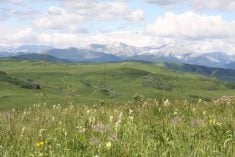SASKATOON – There’s been a lot of changes at the Dafoe air force base since its Second World War heyday.
The bombing and gunnery school 200 kilometres southwest of Saskatoon was home to 1,400 soldiers and 100 to 150 civilians during the war. It opened in 1940 and closed in 1945, said Larry Kunz who has just finished building a model replica of the air force base.
After the war, a skeleton crew was kept at the base for a few months. The base was later used for an emergency landing strip and a Red Cross pickup site. Several of the buildings were taken to nearby communities and used as recreation sites, seniors centres or grain elevators.
Read Also

Selenium not deal breaker in coal mining: expert
Environmental scientist weighs in on coal mining debates in Western Canada, explaining selenium and the technologies and practices to lower its concentrations in nearby waterways to coal mining operations
One remaining hangar at the site has been used for farm storage and doubled as a grain elevator. In June it will become the site of a conservation tillage demonstration day Direct Tech ’95.
There were once six hangars on the training base to house the twin engine bombers. Boling Brooks and Avro Ansons were used for bombing instruction over nearby Quill Lake.
The students dropped the practice bombs on bobbing log targets in the lake.
As well, single engine Lysanders pulled targets, which were dragged about three-quarters of a kilometre behind the plane, as moving targets for gunnery practice.
“The theory was the spent ammunition would hit the Quill Lakes,” said Kunz.
But there were stories of stray bullets hitting barns and nearby farms.
A drill hall used for marching in wet weather was also located on the site. It doubled as a dance hall. Because the base was isolated in those days, it had a swimming pool, bowling alley, movie theatre and hospital. It may have been a fun time at the base, but the life expectancy for soldiers after graduation was only three months, said Kunz, of St. Gregor, Sask.
Kunz was always been interested in the history of the old base and decided to recreate its history in the form of a model. He has finished the model and it will be sent to the Royal Canadian Air Force Memorial museum in Trenton, Ont., as part of the permanent collection.














